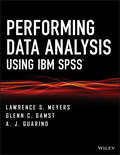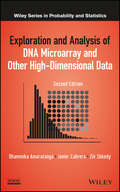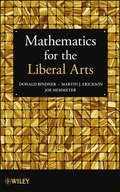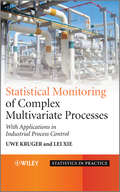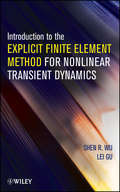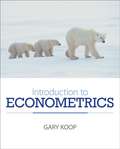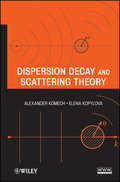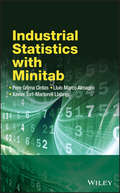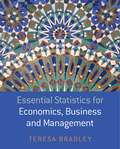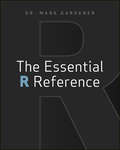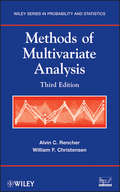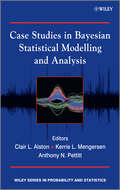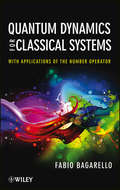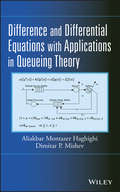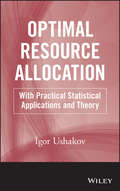- Table View
- List View
Performing Data Analysis Using IBM SPSS
by Lawrence S. Meyers Glenn C. Gamst A. J. GuarinoFeatures easy-to-follow insight and clear guidelines to perform data analysis using IBM SPSS® Performing Data Analysis Using IBM SPSS® uniquely addresses the presented statistical procedures with an example problem, detailed analysis, and the related data sets. Data entry procedures, variable naming, and step-by-step instructions for all analyses are provided in addition to IBM SPSS point-and-click methods, including details on how to view and manipulate output. Designed as a user’s guide for students and other interested readers to perform statistical data analysis with IBM SPSS, this book addresses the needs, level of sophistication, and interest in introductory statistical methodology on the part of readers in social and behavioral science, business, health-related, and education programs. Each chapter of Performing Data Analysis Using IBM SPSS covers a particular statistical procedure and offers the following: an example problem or analysis goal, together with a data set; IBM SPSS analysis with step-by-step analysis setup and accompanying screen shots; and IBM SPSS output with screen shots and narrative on how to read or interpret the results of the analysis. The book provides in-depth chapter coverage of: IBM SPSS statistical output Descriptive statistics procedures Score distribution assumption evaluations Bivariate correlation Regressing (predicting) quantitative and categorical variables Survival analysis t Test ANOVA and ANCOVA Multivariate group differences Multidimensional scaling Cluster analysis Nonparametric procedures for frequency data Performing Data Analysis Using IBM SPSS is an excellent text for upper-undergraduate and graduate-level students in courses on social, behavioral, and health sciences as well as secondary education, research design, and statistics. Also an excellent reference, the book is ideal for professionals and researchers in the social, behavioral, and health sciences; applied statisticians; and practitioners working in industry.
Exploration and Analysis of DNA Microarray and Other High-Dimensional Data (Wiley Series in Probability and Statistics #985)
by Dhammika Amaratunga Javier Cabrera Ziv ShkedyPraise for the First Edition “…extremely well written…a comprehensive and up-to-date overview of this important field.” – Journal of Environmental Quality Exploration and Analysis of DNA Microarray and Other High-Dimensional Data, Second Edition provides comprehensive coverage of recent advancements in microarray data analysis. A cutting-edge guide, the Second Edition demonstrates various methodologies for analyzing data in biomedical research and offers an overview of the modern techniques used in microarray technology to study patterns of gene activity. The new edition answers the need for an efficient outline of all phases of this revolutionary analytical technique, from preprocessing to the analysis stage. Utilizing research and experience from highly-qualified authors in fields of data analysis, Exploration and Analysis of DNA Microarray and Other High-Dimensional Data, Second Edition features: A new chapter on the interpretation of findings that includes a discussion of signatures and material on gene set analysis, including network analysis New topics of coverage including ABC clustering, biclustering, partial least squares, penalized methods, ensemble methods, and enriched ensemble methods Updated exercises to deepen knowledge of the presented material and provide readers with resources for further study The book is an ideal reference for scientists in biomedical and genomics research fields who analyze DNA microarrays and protein array data, as well as statisticians and bioinformatics practitioners. Exploration and Analysis of DNA Microarray and Other High-Dimensional Data, Second Edition is also a useful text for graduate-level courses on statistics, computational biology, and bioinformatics.
Exploration and Analysis of DNA Microarray and Other High-Dimensional Data (Wiley Series in Probability and Statistics)
by Dhammika Amaratunga Javier Cabrera Ziv ShkedyPraise for the First Edition “…extremely well written…a comprehensive and up-to-date overview of this important field.” – Journal of Environmental Quality Exploration and Analysis of DNA Microarray and Other High-Dimensional Data, Second Edition provides comprehensive coverage of recent advancements in microarray data analysis. A cutting-edge guide, the Second Edition demonstrates various methodologies for analyzing data in biomedical research and offers an overview of the modern techniques used in microarray technology to study patterns of gene activity. The new edition answers the need for an efficient outline of all phases of this revolutionary analytical technique, from preprocessing to the analysis stage. Utilizing research and experience from highly-qualified authors in fields of data analysis, Exploration and Analysis of DNA Microarray and Other High-Dimensional Data, Second Edition features: A new chapter on the interpretation of findings that includes a discussion of signatures and material on gene set analysis, including network analysis New topics of coverage including ABC clustering, biclustering, partial least squares, penalized methods, ensemble methods, and enriched ensemble methods Updated exercises to deepen knowledge of the presented material and provide readers with resources for further study The book is an ideal reference for scientists in biomedical and genomics research fields who analyze DNA microarrays and protein array data, as well as statisticians and bioinformatics practitioners. Exploration and Analysis of DNA Microarray and Other High-Dimensional Data, Second Edition is also a useful text for graduate-level courses on statistics, computational biology, and bioinformatics.
Mathematics for the Liberal Arts
by Donald Bindner Martin J. Erickson Joe HemmeterPresents a clear bridge between mathematics and the liberal arts Mathematics for the Liberal Arts provides a comprehensible and precise introduction to modern mathematics intertwined with the history of mathematical discoveries. The book discusses mathematical ideas in the context of the unfolding story of human thought and highlights the application of mathematics in everyday life. Divided into two parts, Mathematics for the Liberal Arts first traces the history of mathematics from the ancient world to the Middle Ages, then moves on to the Renaissance and finishes with the development of modern mathematics. In the second part, the book explores major topics of calculus and number theory, including problem-solving techniques and real-world applications. This book emphasizes learning through doing, presents a practical approach, and features: A detailed explanation of why mathematical principles are true and how the mathematical processes work Numerous figures and diagrams as well as hundreds of worked examples and exercises, aiding readers to further visualize the presented concepts Various real-world practical applications of mathematics, including error-correcting codes and the space shuttle program Vignette biographies of renowned mathematicians Appendices with solutions to selected exercises and suggestions for further reading Mathematics for the Liberal Arts is an excellent introduction to the history and concepts of mathematics for undergraduate liberal arts students and readers in non-scientific fields wishing to gain a better understanding of mathematics and mathematical problem-solving skills.
Statistical Monitoring of Complex Multivatiate Processes: With Applications in Industrial Process Control (Statistics in Practice)
by Uwe Kruger Lei XieThe development and application of multivariate statistical techniques in process monitoring has gained substantial interest over the past two decades in academia and industry alike. Initially developed for monitoring and fault diagnosis in complex systems, such techniques have been refined and applied in various engineering areas, for example mechanical and manufacturing, chemical, electrical and electronic, and power engineering. The recipe for the tremendous interest in multivariate statistical techniques lies in its simplicity and adaptability for developing monitoring applications. In contrast, competitive model, signal or knowledge based techniques showed their potential only whenever cost-benefit economics have justified the required effort in developing applications. Statistical Monitoring of Complex Multivariate Processes presents recent advances in statistics based process monitoring, explaining how these processes can now be used in areas such as mechanical and manufacturing engineering for example, in addition to the traditional chemical industry. This book: Contains a detailed theoretical background of the component technology. Brings together a large body of work to address the field’s drawbacks, and develops methods for their improvement. Details cross-disciplinary utilization, exemplified by examples in chemical, mechanical and manufacturing engineering. Presents real life industrial applications, outlining deficiencies in the methodology and how to address them. Includes numerous examples, tutorial questions and homework assignments in the form of individual and team-based projects, to enhance the learning experience. Features a supplementary website including Matlab algorithms and data sets. This book provides a timely reference text to the rapidly evolving area of multivariate statistical analysis for academics, advanced level students, and practitioners alike.
Introduction to the Explicit Finite Element Method for Nonlinear Transient Dynamics
by Shen R. Wu Lei GuA systematic introduction to the theories and formulations of the explicit finite element method As numerical technology continues to grow and evolve with industrial applications, understanding the explicit finite element method has become increasingly important, particularly in the areas of crashworthiness, metal forming, and impact engineering. Introduction to the Explicit Finite Element Method for Nonlinear Transient Dynamics is the first book to address specifically what is now accepted as the most successful numerical tool for nonlinear transient dynamics. The book aids readers in mastering the explicit finite element method and programming code without requiring extensive background knowledge of the general finite element. The authors present topics relating to the variational principle, numerical procedure, mechanical formulation, and fundamental achievements of the convergence theory. In addition, key topics and techniques are provided in four clearly organized sections: • Fundamentals explores a framework of the explicit finite element method for nonlinear transient dynamics and highlights achievements related to the convergence theory • Element Technology discusses four-node, three-node, eight-node, and two-node element theories • Material Models outlines models of plasticity and other nonlinear materials as well as the mechanics model of ductile damage • Contact and Constraint Conditions covers subjects related to three-dimensional surface contact, with examples solved analytically, as well as discussions on kinematic constraint conditions Throughout the book, vivid figures illustrate the ideas and key features of the explicit finite element method. Examples clearly present results, featuring both theoretical assessments and industrial applications. Introduction to the Explicit Finite Element Method for Nonlinear Transient Dynamics is an ideal book for both engineers who require more theoretical discussions and for theoreticians searching for interesting and challenging research topics. The book also serves as an excellent resource for courses on applied mathematics, applied mechanics, and numerical methods at the graduate level.
Introduction to the Explicit Finite Element Method for Nonlinear Transient Dynamics
by Shen R. Wu Lei GuA systematic introduction to the theories and formulations of the explicit finite element method As numerical technology continues to grow and evolve with industrial applications, understanding the explicit finite element method has become increasingly important, particularly in the areas of crashworthiness, metal forming, and impact engineering. Introduction to the Explicit Finite Element Method for Nonlinear Transient Dynamics is the first book to address specifically what is now accepted as the most successful numerical tool for nonlinear transient dynamics. The book aids readers in mastering the explicit finite element method and programming code without requiring extensive background knowledge of the general finite element. The authors present topics relating to the variational principle, numerical procedure, mechanical formulation, and fundamental achievements of the convergence theory. In addition, key topics and techniques are provided in four clearly organized sections: • Fundamentals explores a framework of the explicit finite element method for nonlinear transient dynamics and highlights achievements related to the convergence theory • Element Technology discusses four-node, three-node, eight-node, and two-node element theories • Material Models outlines models of plasticity and other nonlinear materials as well as the mechanics model of ductile damage • Contact and Constraint Conditions covers subjects related to three-dimensional surface contact, with examples solved analytically, as well as discussions on kinematic constraint conditions Throughout the book, vivid figures illustrate the ideas and key features of the explicit finite element method. Examples clearly present results, featuring both theoretical assessments and industrial applications. Introduction to the Explicit Finite Element Method for Nonlinear Transient Dynamics is an ideal book for both engineers who require more theoretical discussions and for theoreticians searching for interesting and challenging research topics. The book also serves as an excellent resource for courses on applied mathematics, applied mechanics, and numerical methods at the graduate level.
Introduction to Econometrics
by Gary KoopIntroduction to Econometrics has been written as a core textbook for a first course in econometrics taken by undergraduate or graduate students. It is intended for students taking a single course in econometrics with a view towards doing practical data work. It will also be highly useful for students interested in understanding the basics of econometric theory with a view towards future study of advanced econometrics. To achieve this end, it has a practical emphasis, showing how a wide variety of models can be used with the types of data sets commonly used by economists. However, it also has enough discussion of the underlying econometric theory to give the student a knowledge of the statistical tools used in advanced econometrics courses. Key Features: * A non-technical summary of the basic tools of econometrics is given in chapters 1 and 2, which allows the reader to quickly start empirical work. * The foundation offered in the first two chapters makes the theoretical econometric material, which begins in chapter 3, more accessible. * Provides a good balance between econometric theory and empirical applications. * Discusses a wide range of models used by applied economists including many variants of the regression model (with extensions for panel data), time series models (including a discussion of unit roots and cointegration) and qualitative choice models (probit and logit). An extensive collection of web-based supplementary materials is provided for this title, including: data sets, problem sheets with worked through answers, empirical projects, sample exercises with answers, and slides for lecturers. URL: www.wileyeurope.com/college/koop
Dispersion Decay and Scattering Theory
by Alexander Komech Elena KopylovaA simplified, yet rigorous treatment of scattering theory methods and their applications Dispersion Decay and Scattering Theory provides thorough, easy-to-understand guidance on the application of scattering theory methods to modern problems in mathematics, quantum physics, and mathematical physics. Introducing spectral methods with applications to dispersion time-decay and scattering theory, this book presents, for the first time, the Agmon-Jensen-Kato spectral theory for the Schr?dinger equation, extending the theory to the Klein-Gordon equation. The dispersion decay plays a crucial role in the modern application to asymptotic stability of solitons of nonlinear Schr?dinger and Klein-Gordon equations. The authors clearly explain the fundamental concepts and formulas of the Schr?dinger operators, discuss the basic properties of the Schr?dinger equation, and offer in-depth coverage of Agmon-Jensen-Kato theory of the dispersion decay in the weighted Sobolev norms. The book also details the application of dispersion decay to scattering and spectral theories, the scattering cross section, and the weighted energy decay for 3D Klein-Gordon and wave equations. Complete streamlined proofs for key areas of the Agmon-Jensen-Kato approach, such as the high-energy decay of the resolvent and the limiting absorption principle are also included. Dispersion Decay and Scattering Theory is a suitable book for courses on scattering theory, partial differential equations, and functional analysis at the graduate level. The book also serves as an excellent resource for researchers, professionals, and academics in the fields of mathematics, mathematical physics, and quantum physics who would like to better understand scattering theory and partial differential equations and gain problem-solving skills in diverse areas, from high-energy physics to wave propagation and hydrodynamics.
Dispersion Decay and Scattering Theory
by Alexander Komech Elena KopylovaA simplified, yet rigorous treatment of scattering theory methods and their applications Dispersion Decay and Scattering Theory provides thorough, easy-to-understand guidance on the application of scattering theory methods to modern problems in mathematics, quantum physics, and mathematical physics. Introducing spectral methods with applications to dispersion time-decay and scattering theory, this book presents, for the first time, the Agmon-Jensen-Kato spectral theory for the Schr?dinger equation, extending the theory to the Klein-Gordon equation. The dispersion decay plays a crucial role in the modern application to asymptotic stability of solitons of nonlinear Schr?dinger and Klein-Gordon equations. The authors clearly explain the fundamental concepts and formulas of the Schr?dinger operators, discuss the basic properties of the Schr?dinger equation, and offer in-depth coverage of Agmon-Jensen-Kato theory of the dispersion decay in the weighted Sobolev norms. The book also details the application of dispersion decay to scattering and spectral theories, the scattering cross section, and the weighted energy decay for 3D Klein-Gordon and wave equations. Complete streamlined proofs for key areas of the Agmon-Jensen-Kato approach, such as the high-energy decay of the resolvent and the limiting absorption principle are also included. Dispersion Decay and Scattering Theory is a suitable book for courses on scattering theory, partial differential equations, and functional analysis at the graduate level. The book also serves as an excellent resource for researchers, professionals, and academics in the fields of mathematics, mathematical physics, and quantum physics who would like to better understand scattering theory and partial differential equations and gain problem-solving skills in diverse areas, from high-energy physics to wave propagation and hydrodynamics.
Industrial Statistics with Minitab
by Pere Grima Cintas Lluis Marco Almagro Xavier Tort-Martorell LlabresIndustrial Statistics with MINITAB demonstrates the use of MINITAB as a tool for performing statistical analysis in an industrial context. This book covers introductory industrial statistics, exploring the most commonly used techniques alongside those that serve to give an overview of more complex issues. A plethora of examples in MINITAB are featured along with case studies for each of the statistical techniques presented. Industrial Statistics with MINITAB: Provides comprehensive coverage of user-friendly practical guidance to the essential statistical methods applied in industry. Explores statistical techniques and how they can be used effectively with the help of MINITAB 16. Contains extensive illustrative examples and case studies throughout and assumes no previous statistical knowledge. Emphasises data graphics and visualization, and the most used industrial statistical tools, such as Statistical Process Control and Design of Experiments. Is supported by an accompanying website featuring case studies and the corresponding datasets. Six Sigma Green Belts and Black Belts will find explanations and examples of the most relevant techniques in DMAIC projects. The book can also be used as quick reference enabling the reader to be confident enough to explore other MINITAB capabilities.
Industrial Statistics with Minitab
by Pere Grima Cintas Lluis Marco Almagro Xavier Tort-Martorell LlabresIndustrial Statistics with MINITAB demonstrates the use of MINITAB as a tool for performing statistical analysis in an industrial context. This book covers introductory industrial statistics, exploring the most commonly used techniques alongside those that serve to give an overview of more complex issues. A plethora of examples in MINITAB are featured along with case studies for each of the statistical techniques presented. Industrial Statistics with MINITAB: Provides comprehensive coverage of user-friendly practical guidance to the essential statistical methods applied in industry. Explores statistical techniques and how they can be used effectively with the help of MINITAB 16. Contains extensive illustrative examples and case studies throughout and assumes no previous statistical knowledge. Emphasises data graphics and visualization, and the most used industrial statistical tools, such as Statistical Process Control and Design of Experiments. Is supported by an accompanying website featuring case studies and the corresponding datasets. Six Sigma Green Belts and Black Belts will find explanations and examples of the most relevant techniques in DMAIC projects. The book can also be used as quick reference enabling the reader to be confident enough to explore other MINITAB capabilities.
Essential Statistics for Economics, Business and Management
by Teresa BradleyEssential Statistics for Economics, Business and Management assumes no prior knowledge of statistics. It will also be highly relevant for the statistics component of courses in quantitative methods. The style of the book is similar to that of the highly successful Essential Mathematics for Economics and Business by Teresa Bradley and Paul Patton, with many worked examples integrated throughout. Emphasis is placed on verbalising concepts, problems and results of statistical analysis. This will help students learn how to start a problem, complete the calculations, and report the results in a way that makes sense to a non-statistician. Each concept is introduced with a brief but plausible explanation followed by Worked Examples. The Worked Examples will provide students with the necessary practice that they need in order to succeed at the subject. Emphasis is also placed on ?learning through doing? problems. Excel is used to encourage students in doing problems and to enhance understanding (with links to datasets online). Minitab printouts are also included in the text. Skills Development Exercises with brief solutions are included within the chapters, and Progress Exercises on theory and applications are provided at the end of each chapter. Solutions to all the worked examples and progress exercises are available as an appendix. Web-based supplementary materials will be provided for lecturers adopting the text, including additonal exercises and solutions, excel datasets and exercises, powerpoint slides with key formula, figures and tables. Students can access an online glossary and weblinks.
The Essential R Reference
by Mark GardenerAn essential library of basic commands you can copy and paste into R The powerful and open-source statistical programming language R is rapidly growing in popularity, but it requires that you type in commands at the keyboard rather than use a mouse, so you have to learn the language of R. But there is a shortcut, and that's where this unique book comes in. A companion book to Visualize This: The FlowingData Guide to Design, Visualization, and Statistics, this practical reference is a library of basic R commands that you can copy and paste into R to perform many types of statistical analyses. Whether you're in technology, science, medicine, business, or engineering, you can quickly turn to your topic in this handy book and find the commands you need. Comprehensive command reference for the R programming language and a companion book to Visualize This: The FlowingData Guide to Design, Visualization, and Statistics Combines elements of a dictionary, glossary, and thesaurus for the R language Provides easy accessibility to the commands you need, by topic, which you can cut and paste into R as needed Covers getting, saving, examining, and manipulating data; statistical test and math; and all the things you can do with graphs Also includes a collection of utilities that you'll find useful Simplify the complex statistical R programming language with The Essential R Reference. .
The Essential R Reference
by Mark GardenerAn essential library of basic commands you can copy and paste into R The powerful and open-source statistical programming language R is rapidly growing in popularity, but it requires that you type in commands at the keyboard rather than use a mouse, so you have to learn the language of R. But there is a shortcut, and that's where this unique book comes in. A companion book to Visualize This: The FlowingData Guide to Design, Visualization, and Statistics, this practical reference is a library of basic R commands that you can copy and paste into R to perform many types of statistical analyses. Whether you're in technology, science, medicine, business, or engineering, you can quickly turn to your topic in this handy book and find the commands you need. Comprehensive command reference for the R programming language and a companion book to Visualize This: The FlowingData Guide to Design, Visualization, and Statistics Combines elements of a dictionary, glossary, and thesaurus for the R language Provides easy accessibility to the commands you need, by topic, which you can cut and paste into R as needed Covers getting, saving, examining, and manipulating data; statistical test and math; and all the things you can do with graphs Also includes a collection of utilities that you'll find useful Simplify the complex statistical R programming language with The Essential R Reference. .
Methods of Multivariate Analysis (Wiley Series in Probability and Statistics #709)
by Alvin C. Rencher William F. ChristensenPraise for the Second Edition "This book is a systematic, well-written, well-organized text on multivariate analysis packed with intuition and insight . . . There is much practical wisdom in this book that is hard to find elsewhere." —IIE Transactions Filled with new and timely content, Methods of Multivariate Analysis, Third Edition provides examples and exercises based on more than sixty real data sets from a wide variety of scientific fields. It takes a "methods" approach to the subject, placing an emphasis on how students and practitioners can employ multivariate analysis in real-life situations. This Third Edition continues to explore the key descriptive and inferential procedures that result from multivariate analysis. Following a brief overview of the topic, the book goes on to review the fundamentals of matrix algebra, sampling from multivariate populations, and the extension of common univariate statistical procedures (including t-tests, analysis of variance, and multiple regression) to analogous multivariate techniques that involve several dependent variables. The latter half of the book describes statistical tools that are uniquely multivariate in nature, including procedures for discriminating among groups, characterizing low-dimensional latent structure in high-dimensional data, identifying clusters in data, and graphically illustrating relationships in low-dimensional space. In addition, the authors explore a wealth of newly added topics, including: Confirmatory Factor Analysis Classification Trees Dynamic Graphics Transformations to Normality Prediction for Multivariate Multiple Regression Kronecker Products and Vec Notation New exercises have been added throughout the book, allowing readers to test their comprehension of the presented material. Detailed appendices provide partial solutions as well as supplemental tables, and an accompanying FTP site features the book's data sets and related SAS® code. Requiring only a basic background in statistics, Methods of Multivariate Analysis, Third Edition is an excellent book for courses on multivariate analysis and applied statistics at the upper-undergraduate and graduate levels. The book also serves as a valuable reference for both statisticians and researchers across a wide variety of disciplines.
Methods of Multivariate Analysis (Wiley Series in Probability and Statistics #709)
by Alvin C. Rencher William F. ChristensenPraise for the Second Edition "This book is a systematic, well-written, well-organized text on multivariate analysis packed with intuition and insight . . . There is much practical wisdom in this book that is hard to find elsewhere." —IIE Transactions Filled with new and timely content, Methods of Multivariate Analysis, Third Edition provides examples and exercises based on more than sixty real data sets from a wide variety of scientific fields. It takes a "methods" approach to the subject, placing an emphasis on how students and practitioners can employ multivariate analysis in real-life situations. This Third Edition continues to explore the key descriptive and inferential procedures that result from multivariate analysis. Following a brief overview of the topic, the book goes on to review the fundamentals of matrix algebra, sampling from multivariate populations, and the extension of common univariate statistical procedures (including t-tests, analysis of variance, and multiple regression) to analogous multivariate techniques that involve several dependent variables. The latter half of the book describes statistical tools that are uniquely multivariate in nature, including procedures for discriminating among groups, characterizing low-dimensional latent structure in high-dimensional data, identifying clusters in data, and graphically illustrating relationships in low-dimensional space. In addition, the authors explore a wealth of newly added topics, including: Confirmatory Factor Analysis Classification Trees Dynamic Graphics Transformations to Normality Prediction for Multivariate Multiple Regression Kronecker Products and Vec Notation New exercises have been added throughout the book, allowing readers to test their comprehension of the presented material. Detailed appendices provide partial solutions as well as supplemental tables, and an accompanying FTP site features the book's data sets and related SAS® code. Requiring only a basic background in statistics, Methods of Multivariate Analysis, Third Edition is an excellent book for courses on multivariate analysis and applied statistics at the upper-undergraduate and graduate levels. The book also serves as a valuable reference for both statisticians and researchers across a wide variety of disciplines.
Case Studies in Bayesian Statistical Modelling and Analysis (Wiley Series in Probability and Statistics #999)
by Clair L. Alston Kerrie L. Mengersen Anthony N. PettittProvides an accessible foundation to Bayesian analysis using real world models This book aims to present an introduction to Bayesian modelling and computation, by considering real case studies drawn from diverse fields spanning ecology, health, genetics and finance. Each chapter comprises a description of the problem, the corresponding model, the computational method, results and inferences as well as the issues that arise in the implementation of these approaches. Case Studies in Bayesian Statistical Modelling and Analysis: Illustrates how to do Bayesian analysis in a clear and concise manner using real-world problems. Each chapter focuses on a real-world problem and describes the way in which the problem may be analysed using Bayesian methods. Features approaches that can be used in a wide area of application, such as, health, the environment, genetics, information science, medicine, biology, industry and remote sensing. Case Studies in Bayesian Statistical Modelling and Analysis is aimed at statisticians, researchers and practitioners who have some expertise in statistical modelling and analysis, and some understanding of the basics of Bayesian statistics, but little experience in its application. Graduate students of statistics and biostatistics will also find this book beneficial.
Case Studies in Bayesian Statistical Modelling and Analysis (Wiley Series in Probability and Statistics)
by Clair L. Alston Kerrie L. Mengersen Anthony N. PettittProvides an accessible foundation to Bayesian analysis using real world models This book aims to present an introduction to Bayesian modelling and computation, by considering real case studies drawn from diverse fields spanning ecology, health, genetics and finance. Each chapter comprises a description of the problem, the corresponding model, the computational method, results and inferences as well as the issues that arise in the implementation of these approaches. Case Studies in Bayesian Statistical Modelling and Analysis: Illustrates how to do Bayesian analysis in a clear and concise manner using real-world problems. Each chapter focuses on a real-world problem and describes the way in which the problem may be analysed using Bayesian methods. Features approaches that can be used in a wide area of application, such as, health, the environment, genetics, information science, medicine, biology, industry and remote sensing. Case Studies in Bayesian Statistical Modelling and Analysis is aimed at statisticians, researchers and practitioners who have some expertise in statistical modelling and analysis, and some understanding of the basics of Bayesian statistics, but little experience in its application. Graduate students of statistics and biostatistics will also find this book beneficial.
Quantum Dynamics for Classical Systems: With Applications of the Number Operator
by Fabio BagarelloIntroduces number operators with a focus on the relationship between quantum mechanics and social science Mathematics is increasingly applied to classical problems in finance, biology, economics, and elsewhere. Quantum Dynamics for Classical Systems describes how quantum tools—the number operator in particular—can be used to create dynamical systems in which the variables are operator-valued functions and whose results explain the presented model. The book presents mathematical results and their applications to concrete systems and discusses the methods used, results obtained, and techniques developed for the proofs of the results. The central ideas of number operators are illuminated while avoiding excessive technicalities that are unnecessary for understanding and learning the various mathematical applications. The presented dynamical systems address a variety of contexts and offer clear analyses and explanations of concluded results. Additional features in Quantum Dynamics for Classical Systems include: Applications across diverse fields including stock markets and population migration as well as a unique quantum perspective on these classes of models Illustrations of the use of creation and annihilation operators for classical problems Examples of the recent increase in research and literature on the many applications of quantum tools in applied mathematics Clarification on numerous misunderstandings and misnomers while shedding light on new approaches in the field Quantum Dynamics for Classical Systems is an ideal reference for researchers, professionals, and academics in applied mathematics, economics, physics, biology, and sociology. The book is also excellent for courses in dynamical systems, quantum mechanics, and mathematical models.
Quantum Dynamics for Classical Systems: With Applications of the Number Operator
by Fabio BagarelloIntroduces number operators with a focus on the relationship between quantum mechanics and social science Mathematics is increasingly applied to classical problems in finance, biology, economics, and elsewhere. Quantum Dynamics for Classical Systems describes how quantum tools—the number operator in particular—can be used to create dynamical systems in which the variables are operator-valued functions and whose results explain the presented model. The book presents mathematical results and their applications to concrete systems and discusses the methods used, results obtained, and techniques developed for the proofs of the results. The central ideas of number operators are illuminated while avoiding excessive technicalities that are unnecessary for understanding and learning the various mathematical applications. The presented dynamical systems address a variety of contexts and offer clear analyses and explanations of concluded results. Additional features in Quantum Dynamics for Classical Systems include: Applications across diverse fields including stock markets and population migration as well as a unique quantum perspective on these classes of models Illustrations of the use of creation and annihilation operators for classical problems Examples of the recent increase in research and literature on the many applications of quantum tools in applied mathematics Clarification on numerous misunderstandings and misnomers while shedding light on new approaches in the field Quantum Dynamics for Classical Systems is an ideal reference for researchers, professionals, and academics in applied mathematics, economics, physics, biology, and sociology. The book is also excellent for courses in dynamical systems, quantum mechanics, and mathematical models.
Difference and Differential Equations with Applications in Queueing Theory
by Aliakbar Montazer Haghighi Dimitar P. MishevA Useful Guide to the Interrelated Areas of Differential Equations, Difference Equations, and Queueing Models Difference and Differential Equations with Applications in Queueing Theory presents the unique connections between the methods and applications of differential equations, difference equations, and Markovian queues. Featuring a comprehensive collection of topics that are used in stochastic processes, particularly in queueing theory, the book thoroughly discusses the relationship to systems of linear differential difference equations. The book demonstrates the applicability that queueing theory has in a variety of fields including telecommunications, traffic engineering, computing, and the design of factories, shops, offices, and hospitals. Along with the needed prerequisite fundamentals in probability, statistics, and Laplace transform, Difference and Differential Equations with Applications in Queueing Theory provides: A discussion on splitting, delayed-service, and delayed feedback for single-server, multiple-server, parallel, and series queue models Applications in queue models whose solutions require differential difference equations and generating function methods Exercises at the end of each chapter along with select answers The book is an excellent resource for researchers and practitioners in applied mathematics, operations research, engineering, and industrial engineering, as well as a useful text for upper-undergraduate and graduate-level courses in applied mathematics, differential and difference equations, queueing theory, probability, and stochastic processes.
Difference and Differential Equations with Applications in Queueing Theory
by Aliakbar Montazer Haghighi Dimitar P. MishevA Useful Guide to the Interrelated Areas of Differential Equations, Difference Equations, and Queueing Models Difference and Differential Equations with Applications in Queueing Theory presents the unique connections between the methods and applications of differential equations, difference equations, and Markovian queues. Featuring a comprehensive collection of topics that are used in stochastic processes, particularly in queueing theory, the book thoroughly discusses the relationship to systems of linear differential difference equations. The book demonstrates the applicability that queueing theory has in a variety of fields including telecommunications, traffic engineering, computing, and the design of factories, shops, offices, and hospitals. Along with the needed prerequisite fundamentals in probability, statistics, and Laplace transform, Difference and Differential Equations with Applications in Queueing Theory provides: A discussion on splitting, delayed-service, and delayed feedback for single-server, multiple-server, parallel, and series queue models Applications in queue models whose solutions require differential difference equations and generating function methods Exercises at the end of each chapter along with select answers The book is an excellent resource for researchers and practitioners in applied mathematics, operations research, engineering, and industrial engineering, as well as a useful text for upper-undergraduate and graduate-level courses in applied mathematics, differential and difference equations, queueing theory, probability, and stochastic processes.
Optimal Resource Allocation: With Practical Statistical Applications and Theory
by Igor A. UshakovA UNIQUE ENGINEERING AND STATISTICAL APPROACH TO OPTIMAL RESOURCE ALLOCATION Optimal Resource Allocation: With Practical Statistical Applications and Theory features the application of probabilistic and statistical methods used in reliability engineering during the different phases of life cycles of technical systems. Bridging the gap between reliability engineering and applied mathematics, the book outlines different approaches to optimal resource allocation and various applications of models and algorithms for solving real-world problems. In addition, the fundamental background on optimization theory and various illustrative numerical examples are provided. The book also features: An overview of various approaches to optimal resource allocation, from classical Lagrange methods to modern algorithms based on ideas of evolution in biology Numerous exercises and case studies from a variety of areas, including communications, transportation, energy transmission, and counterterrorism protection The applied methods of optimization with various methods of optimal redundancy problem solutions as well as the numerical examples and statistical methods needed to solve the problems Practical thoughts, opinions, and judgments on real-world applications of reliability theory and solves practical problems using mathematical models and algorithms Optimal Resource Allocation is a must-have guide for electrical, mechanical, and reliability engineers dealing with engineering design and optimal reliability problems. In addition, the book is excellent for graduate and PhD-level courses in reliability theory and optimization.
Optimal Resource Allocation: With Practical Statistical Applications and Theory
by Igor A. UshakovA UNIQUE ENGINEERING AND STATISTICAL APPROACH TO OPTIMAL RESOURCE ALLOCATION Optimal Resource Allocation: With Practical Statistical Applications and Theory features the application of probabilistic and statistical methods used in reliability engineering during the different phases of life cycles of technical systems. Bridging the gap between reliability engineering and applied mathematics, the book outlines different approaches to optimal resource allocation and various applications of models and algorithms for solving real-world problems. In addition, the fundamental background on optimization theory and various illustrative numerical examples are provided. The book also features: An overview of various approaches to optimal resource allocation, from classical Lagrange methods to modern algorithms based on ideas of evolution in biology Numerous exercises and case studies from a variety of areas, including communications, transportation, energy transmission, and counterterrorism protection The applied methods of optimization with various methods of optimal redundancy problem solutions as well as the numerical examples and statistical methods needed to solve the problems Practical thoughts, opinions, and judgments on real-world applications of reliability theory and solves practical problems using mathematical models and algorithms Optimal Resource Allocation is a must-have guide for electrical, mechanical, and reliability engineers dealing with engineering design and optimal reliability problems. In addition, the book is excellent for graduate and PhD-level courses in reliability theory and optimization.
